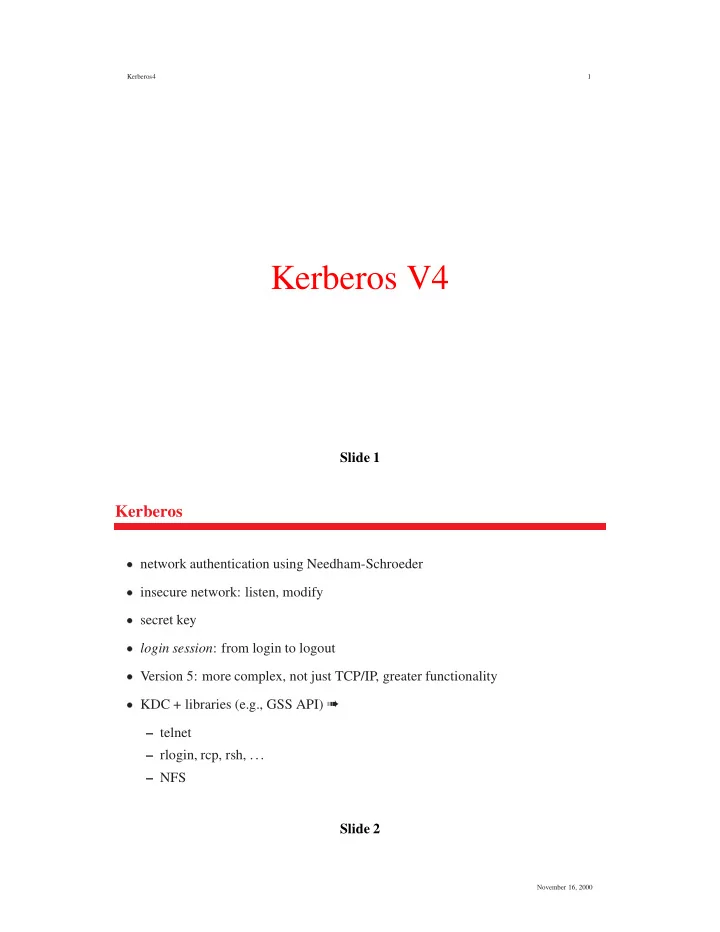

Kerberos4 1 Kerberos V4 Slide 1 Kerberos � network authentication using Needham-Schroeder � insecure network: listen, modify � secret key � login session : from login to logout � Version 5: more complex, not just TCP/IP, greater functionality � KDC + libraries (e.g., GSS API) ➠ – telnet – rlogin, rcp, rsh, ... – NFS Slide 2 November 16, 2000
Kerberos4 2 Tickets and Ticket-Granting Tickets � users, resources: principal ➠ share masterkey with KDC � KDC sends to A : K f K g ; ticket: K f K ; Alice g A AB B AB � tickets expire in 21 hours � thus: knowledge of K AB proves identity + use for encryption � credentials: K AB and ticket � password generates master key � workstation asks for session key S A (time-limited) � ticket-granting ticket (TGT): K KDC f S ; : : : g A � workstation forgets master key, uses TGT � KDC: authentication server (AS) + ticket-granting server (TGS) Slide 3 Configuration � KDC master key encrypts KDC database, TGT � DES-based � principals need to remember pw (humans) or key (machines) Slide 4 November 16, 2000
Kerberos4 3 Logging In � send username � get credentials � ask for password (minimum residency!) � but: can do password-guessing by sending user name � TGT ➠ state-less server (crashes, replication) Slide 5 Communicating with Remote Node rlogin Bob : � authenticator = timestamp ( � N-S) � limit replay: allow skew of 5 min. ➠ time synchronization � construct ticket to Bob Slide 6 November 16, 2000
Kerberos4 4 Replicated KDCs � KDC: single PoF (in addition to NFS...) � ➠ replication with master copy � performance scaling: service location protocol? � exchange master database in clear, protected by secure hash Slide 7 Realms � can’t have single (replicated) KDC: need to limit trust � limit compromise � principal: name (service), instance (host, human role), realm � each realm carries others as principals � no chaining of realms: prevent rogue KDC impersonating everybody � V4: DNS names Slide 8 November 16, 2000
Kerberos4 5 Key Version Numbers � allow unsynchronized changes of master keys � remember several versions of past keys � replication ➠ new passwords may fail Slide 9 Privacy and Integrity � encrypt and protect (e.g., CBC with residue ➠ two passes) � plain-text cipher block chaining (PCBC) � CBC: = ( m � ) E n +1 n +1 n � PCBC: = ( m � � ) E m n +1 n +1 n n � corrupt i : all data > i will be changed � put recognizable string at end � but: can swap two adjacent i ’s Slide 10 November 16, 2000
Kerberos4 6 Integrity � DES CBC residue “too expensive” � algorithm not documented (but not broken) � hash over session key and message; transmit message, checksum � may allow to get session key Slide 11 Network Layer Addresses � TGT, ticket contains Alice’s network layer address � Bob checks connection � ➠ Alice can’t hand off ticket to Ted � ➠ can’t steal session key and use it from elsewhere � ➠ prevent eavesdropping/replay within 5 min. window � does not work with firewalls, mobile nodes � does not support delegation � addresses easily spoofable Slide 12 November 16, 2000
Kerberos4 7 Message Formats timestamp: seconds since 1970-1-1; expires in 2038 D bit: direction to avoid reflection attack lifetime: units of 5 minutes (21 hours) 5 ms timestamp: or sequence number session key: 8 byte DES key B bit: byteorder (little/big-endian) Slide 13 Kerberos vs. NT4.0 Kerberos NT 4.0 KDC PDC (primary domain controller) replicated KDC BDC (backup domain controller) realm domain (= 1 PDC, � 1 BDC) interrealm auth. trust between domains Slide 14 November 16, 2000
Recommend
More recommend